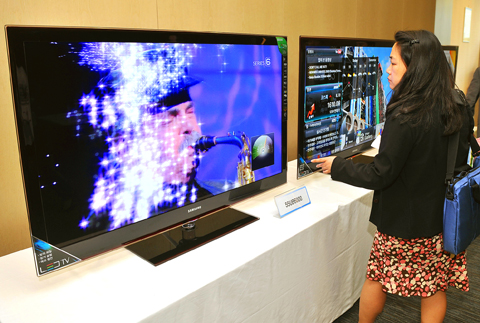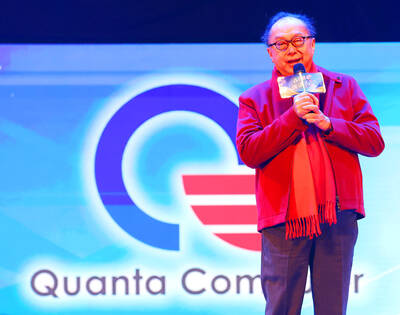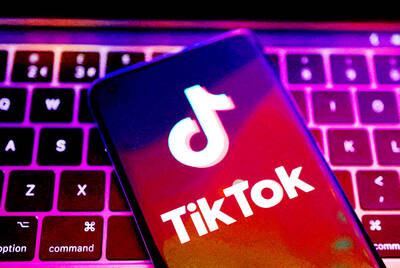The world’s top two makers of flat-panel TVs are stressing the energy-saving virtues of different display technologies in their race to dominate a huge global market.
With liquid-crystal-display (LCD) models storming the world market, attention is focusing on developing a greener version that needs less power.
South Korea’s Samsung Electronics is talking up its LED (light emitting diode) backlit model.

PHOTO: AFP
Rival LG Electronics hails what it calls next-generation technology using AM OLEDs (active matrix organic light emitting diodes).
Each firm is, however, developing both types of flat panel to meet ever-growing demand.
LCD TVs captured 67.3 percent of the world market in the second quarter to June, plasma display panels 6.9 percent and conventional cathode ray tube models 25.7 percent, US-based market researcher DisplaySearch says.
Samsung launched its new LED-backlit models in the middle of March and says it sold 600,000 of them as of June.
Yoon Boo-keun, president of its TV business, said the multinational aims to sell more than 2 million LED-backlit units this year — some 10 percent of its projected 22 million sales of all LCD units.
Yoon said LED TVs reduce energy consumption by up to 40 percent over traditional LCD screens.
“If every TV in the world switched to LED, we could save 13 million kilowatts of electricity — enough to supply all 39 million households in Germany,” he told a global electronics fair in Berlin on Friday.
“I’m sure Samsung will continue to lead the LED TV market,” Shim Sue, senior vice president of sales and marketing for the TV business, told a recent media briefing.
DisplaySearch figures show Samsung supplied 23 percent of all flat-panel models in the second quarter, LG Electronics 13.7 percent, Sony 11.8 percent, Panasonic 8.6 percent and Sharp 6.4 percent.
LCDs are power-greedy because they consist of two key units — a backlit unit which shines a constant white light and a screen unit that filters out some of the light to create colored images.
Samsung’s latest models change the backlit source from power-gulping cold compact fluorescents to energy-efficient LEDs.
Kim Hyun-suk, senior vice president of the firm’s research and development unit, said LED-backlit models could also save energy by arraying the diodes on the edges and not the back of the screen.
“The edge-type has significantly reduced the number of LEDs for the backlight unit and thus need less power and less cost,” Kim said.
“The Samsung Electronics LED-backlit model is just another type of LCD TV,” an LG Electronics official said on condition of anonymity. “They don’t deserve to be called LED TVs. It’s misleading.”
Britain’s Advertising Standards Authority agreed, telling Samsung last month to change its advertisement for the new model.
“We considered that the ad implied the TV displays were comprised totally of LEDs, similar to some outdoor displays, when that was not the case,” it said.
The LG official said the “real post-LCD TVs” should use AM OLEDs for the display panel.
This, he said, does not need a backlit unit and thus requires less power.
It can also guarantee a much thinner panel and a quicker response time for high definition.
LG engineers say an AM OLED TV consumes less than half the power of existing LCD sets and its response time is vastly quicker.
AM OLEDs are used in cellphones and other small displays. But high production costs and other technological challenges have restricted their wider use.
Japan’s Sony launched an 11-inch OLED TV in 2007 and last month LG Electronics launched a 15-inch model, which will be commercially produced from November.
“With the commercial production, we will lead the OLED TV market, the next-generation display market,” Kwon Hee-won, vice president of LG Electronics’ LCD TV business, said in a statement.

Quanta Computer Inc (廣達) chairman Barry Lam (林百里) is expected to share his views about the artificial intelligence (AI) industry’s prospects during his speech at the company’s 37th anniversary ceremony, as AI servers have become a new growth engine for the equipment manufacturing service provider. Lam’s speech is much anticipated, as Quanta has risen as one of the world’s major AI server suppliers. The company reported a 30 percent year-on-year growth in consolidated revenue to NT$1.41 trillion (US$43.35 billion) last year, thanks to fast-growing demand for servers, especially those with AI capabilities. The company told investors in November last year that

Intel Corp has named Tasha Chuang (莊蓓瑜) to lead Intel Taiwan in a bid to reinforce relations between the company and its Taiwanese partners. The appointment of Chuang as general manager for Intel Taiwan takes effect on Thursday, the firm said in a statement yesterday. Chuang is to lead her team in Taiwan to pursue product development and sales growth in an effort to reinforce the company’s ties with its partners and clients, Intel said. Chuang was previously in charge of managing Intel’s ties with leading Taiwanese PC brand Asustek Computer Inc (華碩), which included helping Asustek strengthen its global businesses, the company

Taiwanese suppliers to Taiwan Semiconductor Manufacturing Co. (TSMC, 台積電) are expected to follow the contract chipmaker’s step to invest in the US, but their relocation may be seven to eight years away, Minister of Economic Affairs J.W. Kuo (郭智輝) said yesterday. When asked by opposition Chinese Nationalist Party (KMT) Legislator Niu Hsu-ting (牛煦庭) in the legislature about growing concerns that TSMC’s huge investments in the US will prompt its suppliers to follow suit, Kuo said based on the chipmaker’s current limited production volume, it is unlikely to lead its supply chain to go there for now. “Unless TSMC completes its planned six

TikTok abounds with viral videos accusing prestigious brands of secretly manufacturing luxury goods in China so they can be sold at cut prices. However, while these “revelations” are spurious, behind them lurks a well-oiled machine for selling counterfeit goods that is making the most of the confusion surrounding trade tariffs. Chinese content creators who portray themselves as workers or subcontractors in the luxury goods business claim that Beijing has lifted confidentiality clauses on local subcontractors as a way to respond to the huge hike in customs duties imposed on China by US President Donald Trump. They say this Chinese decision, of which Agence